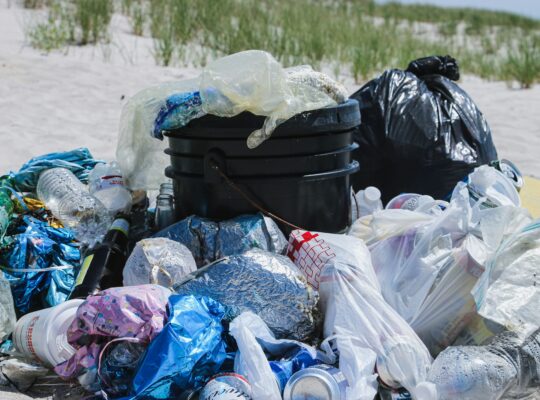Beyond the hype: Exploring the potential and challenges of sustainable aviation fuels and e-Kerosene.
Air transportation is estimated to contribute around 2.4% of global CO2 emissions and around 4% of global warming to date. While this may seem relatively small, it’s important to consider that air travel and air-based logistics is a rapidly growing sector, and its emissions are expected to increase significantly in the coming years.
The aviation industry, a vital driver of global connectivity, is a significant contributor to greenhouse gas emissions. Sustainable Aviation Fuel (SAF) offers a promising solution, but with two main contenders vying for dominance: biofuel SAF and e-kerosene. Understanding their unique strengths and weaknesses, along with potential alternatives and ongoing critique, is key to navigating the path toward cleaner skies.
See also: Electric Airplanes; How MIT Researchers Could Electrify Aviation With New Engine Design.
Biofuel SAF:
Biofuel Sustainable Aviation Fuel is a jet fuel derived from renewable sources like plant oils, animal fats, or even dedicated energy crops. Companies like Neste and World Energy are already producing biofuel sustainable aviation fuel that airlines are incorporating into their flights. A key advantage is its compatibility with existing infrastructure – airplanes can seamlessly use blends of biofuel SAF with conventional jet fuel.
However, biofuel SAF’s environmental impact depends on its production methods. While the feedstocks themselves are renewable, processing them may still rely on conventional energy sources, reducing their overall sustainability. Additionally, large-scale production can be limited by land availability and competition with food production. Finding the right balance between sustainability and scalability remains a challenge for biofuel SAF.
E-Kerosene:
E-kerosene, also known as electrofuels or synthetic kerosene, offers a potentially cleaner alternative. This futuristic fuel is produced using captured carbon dioxide (CO2) and renewable electricity. The CO2 can be obtained from the air through Direct Air Capture (DAC) technology, creating a closed carbon loop. Renewable sources like solar or wind power then create hydrogen through electrolysis. These elements are then combined to create synthetic hydrocarbons that can be refined into e-kerosene, virtually identical to conventional jet fuel in terms of performance.
The potential benefits of e-kerosene are significant. By relying on renewable energy sources throughout its production cycle, e-kerosene has the potential for a near-zero carbon footprint. Additionally, its reliance on captured CO2 and renewable electricity offers much higher scalability compared to biofuel SAF. However, the technology for e-kerosene production is still under development. The first commercial plants are emerging, but widespread adoption remains years away. Additionally, some infrastructure adjustments might be needed at airports to accommodate this new fuel.
Biofuel SAF vs. E-Kerosene:
While they share the goal of greener skies, biofuel sustainable aviation fuel and e-kerosene take different approaches. Biofuel SAF is a readily available option that can reduce emissions now, but its environmental impact depends on production methods. E-kerosene has the potential for a much lower carbon footprint and higher scalability, but it’s a technology still in its early stages.
Emerging Alternatives and Greenwashing:
Beyond biofuel SAF and e-kerosene, alternative fuels like ammonia are being explored. Ammonia offers potential advantages like easier storage than hydrogen, but significant technical hurdles and safety considerations need to be addressed. It’s important to note that some environmental groups have criticized the entire concept of SAF as a form of “greenwashing,” arguing that it allows the aviation industry to continue its high-emission practices with a minor green sheen. Addressing these concerns by ensuring sustainable production methods and focusing on truly low-carbon alternatives will be crucial for the long-term success of sustainable aviation fuel.
Widespread Adoption:
Both biofuel sustainable aviation fuel and e-kerosene face challenges. Biofuel SAF needs to ensure its production methods are truly sustainable, while e-kerosene requires further technological advancements and infrastructure investment. Governments and industry players are crucial in addressing these challenges. Policies and incentives that promote the use of renewable energy in biofuel SAF production and support the development of e-kerosene technology are essential.
Looking ahead, the two technologies might co-exist for some time. Biofuel sustainable aviation fuel can play a vital role in the near term, offering a readily available option for reducing emissions. As e-kerosene matures, it has the potential to take over as the dominant SAF due to its potentially lower environmental impact and higher scalability.
Sustainable Flight:
The development and adoption of SAF are critical for the aviation industry’s journey towards sustainability. Biofuel sustainable aviation fuel and e-kerosene offer distinct pathways, each with its own advantages and challenges. By understanding their differences, addressing concerns over greenwashing, and supporting ongoing advancements, we can pave the way for cleaner skies and a more sustainable future for air travel. The collaborative efforts of industry, governments, researchers, and environmental groups hold the key to unlocking the full potential of SAF and ensuring a smooth takeoff for a greener aviation era.










